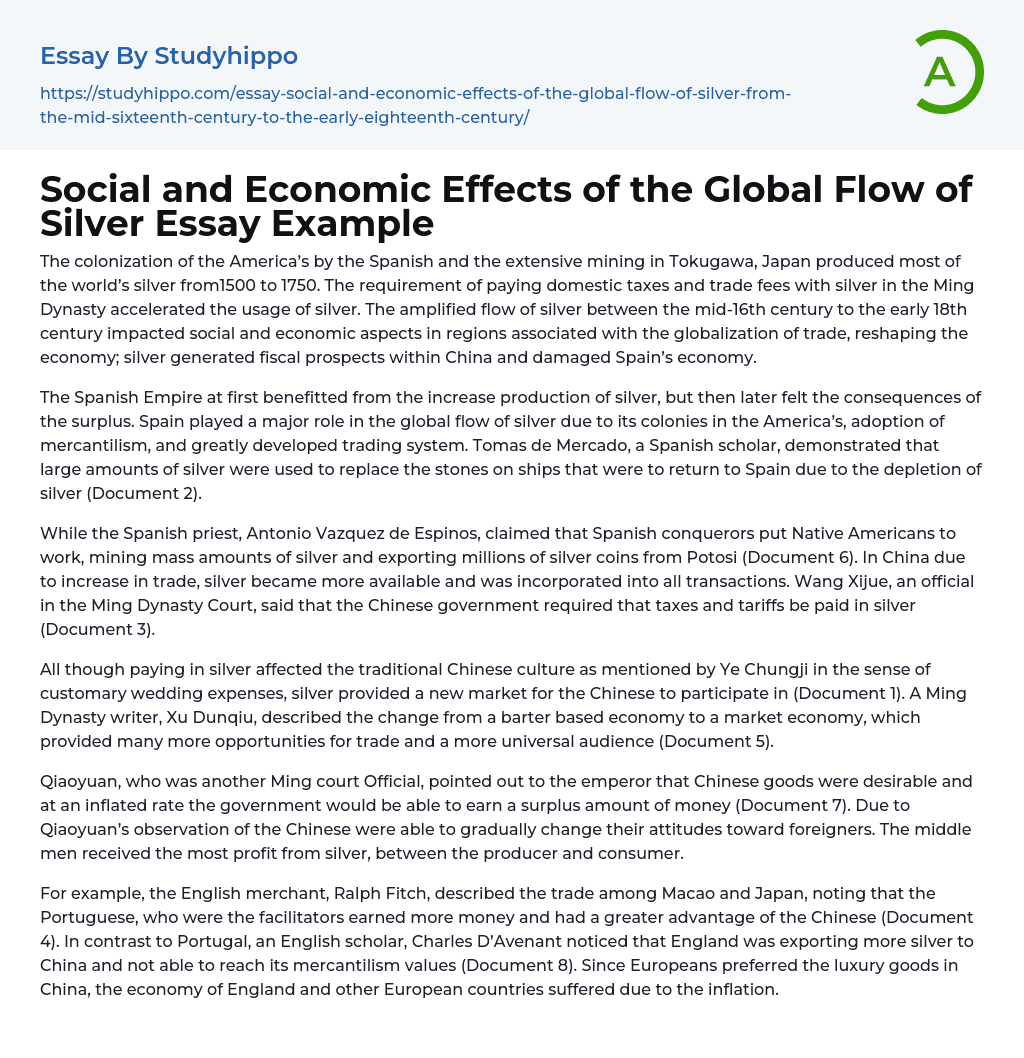

Social and Economic Effects of the Global Flow of Silver Essay Example
The colonization of the America’s by the Spanish and the extensive mining in Tokugawa, Japan produced most of the world’s silver from1500 to 1750. The requirement of paying domestic taxes and trade fees with silver in the Ming Dynasty accelerated the usage of silver. The amplified flow of silver between the mid-16th century to the early 18th century impacted social and economic aspects in regions associated with the globalization of trade, reshaping the economy; silver generated fiscal prospects within China and damaged Spain’s economy.
The Spanish Empire at first benefitted from the increase production of silver, but then later felt the consequences of the surplus. Spain played a major role in the global flow of silver due to its colonies in the America’s, adoption of mercantilism, and greatly developed trading system. Tomas
...de Mercado, a Spanish scholar, demonstrated that large amounts of silver were used to replace the stones on ships that were to return to Spain due to the depletion of silver (Document 2).
While the Spanish priest, Antonio Vazquez de Espinos, claimed that Spanish conquerors put Native Americans to work, mining mass amounts of silver and exporting millions of silver coins from Potosi (Document 6). In China due to increase in trade, silver became more available and was incorporated into all transactions. Wang Xijue, an official in the Ming Dynasty Court, said that the Chinese government required that taxes and tariffs be paid in silver (Document 3).
All though paying in silver affected the traditional Chinese culture as mentioned by Ye Chungji in the sense of customary wedding expenses, silver provided a new market for the Chinese t
participate in (Document 1). A Ming Dynasty writer, Xu Dunqiu, described the change from a barter based economy to a market economy, which provided many more opportunities for trade and a more universal audience (Document 5).
Qiaoyuan, who was another Ming court Official, pointed out to the emperor that Chinese goods were desirable and at an inflated rate the government would be able to earn a surplus amount of money (Document 7). Due to Qiaoyuan’s observation of the Chinese were able to gradually change their attitudes toward foreigners. The middle men received the most profit from silver, between the producer and consumer.
For example, the English merchant, Ralph Fitch, described the trade among Macao and Japan, noting that the Portuguese, who were the facilitators earned more money and had a greater advantage of the Chinese (Document 4). In contrast to Portugal, an English scholar, Charles D’Avenant noticed that England was exporting more silver to China and not able to reach its mercantilism values (Document 8). Since Europeans preferred the luxury goods in China, the economy of England and other European countries suffered due to the inflation.
- Bangladesh essays
- China essays
- Hong Kong essays
- India essays
- Japan essays
- Kuala Lumpur essays
- Malaysia essays
- Manila essays
- Pakistan essays
- Philippines essays
- Singapore essays
- Vietnam essays
- Vietnamese essays
- Accountability essays
- Accounting Software essays
- Accounts Receivable essays
- Auditor's Report essays
- Balance Sheet essays
- Cash essays
- Cash Flow essays
- Costs essays
- Financial Audit essays
- Internal Control essays
- International Financial Reporting Standards essays
- Management Accounting essays
- Principal essays
- Tax essays
- American Dream essays
- Barriers To Entry essays
- Capitalism essays
- Central Bank essays
- Compensation essays
- Consumerism essays
- Economic Development essays
- Economic Growth essays
- Economic Inequality essays
- Economic System essays
- Economy essays
- Employment essays
- Export essays
- Finance essays
- Free Trade essays
- Gross Domestic Product essays
- Human Development essays
- Income Inequality essays
- Industry essays
- Inflation essays
- International Business essays
- International Trade essays
- Macroeconomics essays



